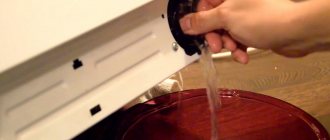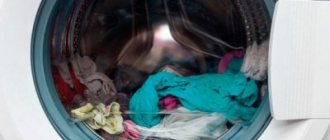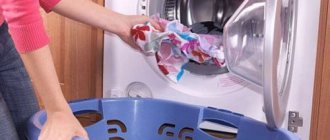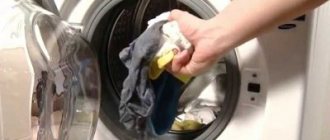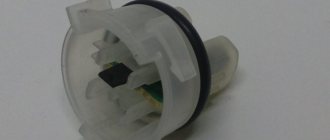List of possible problems
You shouldn't tolerate wet laundry. Finishing a thankless job with the washing machine is not only unpleasant and time-consuming, but what’s worse is that an unresolved breakdown can aggravate the problem to the point of a disastrous outcome. To know where to look for a problem, you need to understand the range of possible causes of a failed spin cycle. For Beko models we are talking about the following situations:
- No spin program selected;
- there is an imbalance in the drum;
- the drain does not function;
- the tachogenerator has failed;
- the electric motor broke down;
- drum bearings are worn out;
- the control board does not work;
- a foreign body has entered the tank, preventing the drum from spinning.
In 99% of cases, the problem that has arisen can be solved independently. The help of a professional repairman is only needed if the control module is burned out. All that remains is to correctly diagnose the source of the problem, for which it is enough to consistently check each possible option. Step-by-step instructions are given below.
Special cases: different models
Of course, the reasons for failures of one washing machine manufacturer do not always coincide with others; sometimes this also applies to models of the same brand.
The thing is that some malfunctions are associated with mechanical damage to parts, and some directly with the program.
Almost all models of the companies Zanussi, Indesit, Bosch, Kandy, Samsung, Lzh and others can be damaged due to the breakdown of such parts as heating elements, pumps, level sensors and pumps with belts.
Let's check the washing program
First of all, it is recommended to weed out trouble-free situations. Often there is no breakdown, since by mistake the user turns on a mode that does not involve intensive rotation of the drum. Thus, spinning is not provided for delicate washing and for wool, silk, and down programs.
To confirm your suspicions, you need to remember the selected button and read its description in the factory instructions. Next time, just change the mode or additionally turn on the spin cycle. The second thing we check is whether the spin cycle was accidentally canceled in the standard program.
Important! Don't forget to lock the dashboard, which will help you avoid worrying about accidental switching.
Many modern models allow you to vary the rotation speed of the drum up to its complete cancellation. It’s better to do a test: select a mode, set the push-up to maximum and start the machine again. Wet items will be a reason for further inspection.
Why the Beko washing machine does not spin - the main reasons
This public offer Agreement, hereinafter referred to as the Agreement, defines the relationship between the administrator of the beko-remont.ru domain, hereinafter referred to as the Administrator, on the one hand, and the visitor to the beko-remont.ru website, hereinafter referred to as the Visitor, who accepted this offer to conclude an Agreement by carrying out actual actions to fill out an online form, application or call the contact phone number indicated on the Site, or send an email or application to other contact information indicated on the Site.
Clarifications of terms and definitions
1.1. Administrator’s website – website: https://www.beko-remont.ru.
1.2. Site Service - navigation capabilities, receiving and sending information available for use on the Site by the Visitor.
Subject of the Agreement
2.1. The Administrator provides the Visitor with access to the Site Service, and the Visitor undertakes to use the Service in accordance with the terms of this Agreement.
2.2. The Administrator undertakes to accept information from the Visitor, including requests for repair work.
2.3. The Administrator undertakes to transfer information and requests for repair work received from the Visitor to potential contractors, subcontractors and other persons at the discretion of the Administrator.
Let's look at the laundry in the drum
The spin cycle of a Beko machine often does not work due to an imbalance in the drum. Overload, insufficient loading or uneven distribution of laundry along the walls of the tank leads to imbalance. This problem occurs with older models, since modern machines are equipped with a special function that controls the balance during washing and spinning.
It’s easy to suspect something is wrong: in this case, the unit repeatedly tries to spin up, but to no avail. As a result, the cycle ends 7-15 minutes earlier than the scheduled time, and the laundry remains wet. You can correct the situation as follows:
- Wait until the hatch is unlocked and open the door.
- Take out half of the laundry (if there was an overload), unravel the twisted “lump” or add items (if there is a shortage).
- Close the hatch tightly.
- Start spinning.
- Check the laundry for dryness.
Imbalance has a detrimental effect on the shock absorbers, bearing assembly and shaft, so it is best to avoid it. It is important to control the amount of laundry loaded and remember both the upper and lower limits. So, in a machine with a capacity of up to 5 kg, it is necessary to wash at least 1 kg, and in washing machines with a maximum capacity of 8-9 kg - 2.5 kg.
Waste water is not removed
If at the end of the cycle there are not only wet things in the drum, but also a full tank of water, you should pay attention to the drainage system. It is quite possible that the machine simply cannot drain the waste liquid due to a burnt-out pump, a blocked pump impeller, or a blockage in the hoses or pipes. We look for a specific cause and its solution in the following sequence:
- We disconnect the drain hose from the sewer and probe its length for blockages. If foreign objects are found, unscrew the pipe completely and rinse it under strong water pressure.
Attention! Sometimes the general sewer becomes clogged, so we lower the disconnected end of the drain hose into the sink or bathtub, start the drain or spin mode and wait for the water to flow.
- We find the drain hatch in the lower right corner of the washing machine body and, using a screwdriver, pry it open. We substitute a container for collecting water and unscrew the garbage filter. Clean the part and the fittings suitable for it. If everything is clean, we test the contacts with a multimeter.
- We check the integrity of the pump. We free the impeller from wound hair and fur, clean the pump body and measure the amount of resistance present.
The pump and filter cannot be repaired and, in case of breakdown, are replaced with new ones. After all the manipulations, we start the machine for the fastest wash and monitor the drainage of water. An empty drum will eliminate the fault of the drain system.
Causes
If the machine does not drain water or spin things out, you should first find out the reason. In this situation, the reasons are divided into two types:
- Problem during operation:
- clogged drain hose, filter or pipe,
- incorrectly connected hose,
- Wrong choice of washing program.
- Breaking:
- breakdown of the pressure switch - the water level sensor in the machine, which is responsible for timely drainage,
- failure of the electronic drain system,
- electric pump failure.
In the first case, you can fix the problem yourself, but in case of a serious breakdown you will have to contact a specialist.
Hall sensor does not function
Spin does not work even if the tachogenerator is faulty. This device, also called a Hall sensor, is responsible for monitoring the number of revolutions made by the engine and transmitting information to the control board. If it breaks, communication with the module is lost, the system stops receiving information and, for safety reasons, reduces the motor power.
Breakdown is caused by improper operation of the machine, in particular:
- Regular overload of the machine with laundry.
- Prolonged use of the machine without stopping.
- Loose fastenings.
- Loose contacts or damaged wiring.
- Severe voltage surge or short circuit.
First of all, we inspect the wires and, if necessary, tighten the terminals, clean and insulate the conductors. Next, we call the sensor itself a multimeter and evaluate the results. In case of deviations from the norm, we replace it with an analogue.
The motor does not spin the drum
Another situation arises when the engine is not able to accelerate to the required power. For commutator motors, braking is possible when the electric brushes are worn out: washing and rinsing proceed normally, but spinning becomes impossible. If other stages of the cycle are difficult to complete, the engine itself may also break down. The guess is checked in the following way:
- We disconnect the machine from all communications.
- Unscrew the back cover.
- Remove the drive belt.
- We disconnect all connected places.
- Loosen the holding fasteners.
- We rock the motor and take it out of the grooves.
Next, wipe the body with a cloth and inspect for damage. A burnt-out engine has an unpleasant burning smell, stains and charred wires. Then we pay attention to the electric brushes: remove them from both sides of the engine, open them and measure the length of the tip. If it is less than 0.7 mm, you will have to change the pair to a new one. At the same time we call the coils.
The washing machine does not spin or drain water - what should I do?
Almost every tenth call to our specialists begins with a similar question and almost always the same answer follows: you need to figure it out on the spot, since it’s impossible to say offhand what’s wrong with your favorite “home assistant.” If the washing machine does not drain the water, and even refuses to spin the laundry, it is not necessarily a malfunction; the problem may well be caused by trivial reasons, but, as they say, let’s not get ahead of ourselves.
Learning to use a machine
Some users believe that since they bought an automatic washing machine, that means washing and everything else should be done automatically in it. Their task seems to boil down to just throwing the laundry into the drum and adding washing powder with conditioner to the cuvette, and then it’s a matter of technology. This is a very common misconception, and the misconception, in some cases, is fatal for the washing machine.
You need to strictly monitor the program or function you choose for a specific washing machine model. A wrong choice or simple carelessness can harm not only the item, but also the washing machine itself. Suppose you mistakenly select the intensive wash mode and put sneakers in the drum. After spinning at a speed of 1200 rpm, the shoes will probably turn into rags, and the drum itself will not be too bad.
Strictly monitor the process of putting laundry into the drum. There is no need to overload the washing machine with laundry, but at the same time, you should not put too many clothes. An average load would be optimal, for example, if your washing machine has a maximum load of 7 kg, then put no more than 5.5-6 kg of dry dirty laundry. In this case, the spin cycle will be excellent, and the quality of washing and rinsing will certainly please you, of course, if other conditions are met.
Not only the weight is important, but also the volume of things placed in the drum. If the laundry is light but bulky, there is no need to compact it by filling the drum full; the quality of the wash will suffer greatly from this.
Watch what you put in the washing machine drum. Make sure that things are sorted by color and type of fabric before putting them into the machine. Fading items should be washed separately. Carefully inspect the laundry before washing, first of all the pockets, they must be empty. If items have poorly sewn buttons or any decorative items, they need to be sewn securely. You should not machine wash items that have rhinestones and other decorations glued on them; nothing good will come of it.
Be sure to unscrew and clean the garbage filter approximately once every two weeks. If you let your washing machine get to the point where its filter becomes clogged, you will have problems draining the water. In addition to the filter, once every three months you need to do a general cleaning of the washing machine. If you don’t know how to do this, read the article Cleaning the washing machine yourself. It describes the entire process in detail.
The above rules must not be neglected under any circumstances. Even if you have a state-of-the-art automatic washing machine with intelligent control. Any washing machine requires attention and care, and if you take care of your equipment properly, it will repay you handsomely.
The way you install the washing machine is how it will work.
Often, a washing machine does not spin or drain water because the user initially installed it incorrectly. In this case, connecting the drain hose to the sewer plays an important role. If the hose is connected incorrectly to the siphon and sewer pipe, a siphon effect will often occur. Waste water and wastewater will flow from the sewer back into the bowels of the washing machine. The washing machine pump is usually low-power; it is simply not able to overcome the siphon effect.
As a result, we constantly receive system errors, and the washing machine does not drain water or spin clothes. Moreover, the wastewater that flows from the sewer into the washing machine will contaminate the laundry located there. And when you open the hatch, you will feel an unpleasant smell coming from there.
If the washing machine cannot drain the water, then the spin cycle will not start; in general, the incorrect location of the drain hose gives rise to a whole range of problems.
There is only one way to solve these problems - to correctly connect the washing machine to the sewer. In addition to connecting to the sewer, you need to make sure that the “home assistant” is installed level on a flat and durable surface. Otherwise, the washing machine will periodically stop spinning due to the resulting imbalance, which in turn is caused by the fact that the washing machine body is installed unevenly, on an unreliable surface.
Damage to the pump and pressure switch
Very often, a washing machine does not drain water not at all because of user errors, but for completely objective reasons - due to a malfunction. Not every breakdown gives rise to such symptoms, so we need to figure out what components of the washing machine to pay attention to if suddenly the “home assistant” stops draining and spinning. First of all, you need to look at the following details:
- drain pump;
- peresostat (water level sensor);
- drive belt;
- Hall Sensor;
- engine;
- electronic module.
Let's start by checking the pump. Indirectly, a malfunction of the pump is indicated by the absence of a specific sound from the drain pump when the water starts draining. If the pump does not turn on within a few minutes, the washing machine automatically stops working and generates an error with a certain code, displaying it on the display. If this is familiar to you, you can start checking the drain pump with peace of mind.
In most cases, it is better to do this from the bottom of the washing machine. If the “home assistant” has a tray, remove it; if there is no tray, simply take out the powder receptacle and place the washing machine on the left wall. We unscrew the pump and disassemble it. We inspect the internal parts, first of all the impeller, clean the insides from dirt and foreign objects. Next, use a multimeter to measure the resistance at the contacts. Having unscrewed the pump, you need to at the same time remove and check the drain pipe, in case a blockage has formed there.
Next in line is the pressure switch. This sensor also needs to be checked. It is located under the top cover of most washing machines. You can read about how to check the pressure switch on a washing machine in the article of the same name.
Drive belt, tachometer or motor
Problems with spinning are often caused by the drive belt. If the belt becomes damaged or simply stretched, it loses its ability to transmit engine speed at high speeds. As a result, the machine performs washing and rinsing normally, since these stages of the program do not require high-speed rotation of the drum. As for spinning, serious problems arise here. Even if the spin cycle does start, the set of laundry spun in this way can then be safely wrung out by hand.
With a stretched drive belt, even a working commutator motor of a washing machine is not able to spin the drum at a speed of more than 600 rpm. Although, of course, you need to take into account the degree of belt wear, but if you resort to rough calculations, this is how it turns out. This problem can be solved quite simply. You need to buy a new belt and replace it. However, keep in mind that the belt must be original.
The machine can wring out laundry more or less efficiently at a speed of at least 800 rpm; if the speed is lower, the laundry will remain wet.
Next to the drive belt, the engine and tachometer are always checked. We have already repeatedly described how to check these two elements in earlier publications, and we don’t want to repeat ourselves at all.
Electronic unit malfunction
The worst thing is when the electronics fail. In this case, the triac responsible for spinning burns out, the engine does not receive a command to accelerate and is not able to accelerate the drum. Only a specialist can determine that the reason is in the module, so if you have the slightest suspicion, you should contact the service department.
It is not recommended to repair the module yourself. There is a high probability that a lack of experience, equipment and professionalism will result in the final failure of the board. A replacement part is expensive and it is cheaper to pay for the services of a specialist.
Foreign object in tank
A foreign object caught in the tank also prevents the drum from unwinding. Here it is necessary to react as quickly as possible: a foreign body can damage the walls of the containers and lead to jamming of the entire system. Replacing a tank is very expensive, so at the slightest suspicion it is recommended to stop the machine and remove the dangerous element.
It’s not easy to get a thing, and it’s better to first confirm the diagnosis. To do this, unplug the machine from the network, drain the water, open the hatch door and turn the drum in both directions. The resistance encountered clearly indicates an existing obstacle, so let's get down to business:
- We check that the unit is disconnected from the power supply.
- Turn off the water and disconnect the drain hose.
- We provide free access to the machine from all sides.
- Unscrew the bolts from the back and remove the back wall.
Important! Find out in advance in the instructions on which side the heating element is located in your VEKO model.
- Finding the location of the heating element.
- We take a photo of the heater so that we don’t mix up the wires when we return.
- Loosen the retaining bolts and remove the heating element.
- We insert our fingers or long-nose pliers into the vacant space and pull out the object that has fallen into the tank.
When the trouble has left the machine, it is worth carrying out an extraordinary cleaning for the heating element. Scrape its surface from scale and dirt, not forgetting to clean the contacts. Then we return everything to its place and test the rotation of the drum.
Bearing problems
You can suspect that a faulty bearing assembly is to blame for a poor-quality spin by the sounds emanating from the operating machine. Unusual noise, creaking, knocking indicate that the seals have served their seven-year life and have leaked, ruining the bearings with washed out grease and corrosion. It is impossible to return these elements to their factory condition - only replace both the bearings and seals with similar parts.
Here the instructions on what to do will not be short and simple. Firstly, it is necessary to find suitable replacement analogues, based on the serial number of the VEKO model. Secondly, disassemble almost the entire machine, right down to removing the counterweights and tank. Thirdly, carefully knock out the rusted rings without damaging the shaft and drum walls. Complicating the work is the lack of a special puller for an amateur repairman, as well as a number of other tools and consumables.
Before getting down to business, you should weigh all the pros and cons and decide exactly whether you have enough strength and experience for such work. There is a high probability of damaging the wiring, ruining the pipes or puncturing the tank. But it is worth taking into account the high cost of such repairs: on average, replacing a bearing assembly and seals costs a third of the price of a new washing machine.
But no one forbids you to first get to know the process in more detail and evaluate your strengths. The main thing is to carefully think through all the actions, prepare everything you need and enlist the help of an extra pair of hands. Step-by-step instructions for changing bearings yourself are given in this article.
Interesting:
- The Atlant washing machine does not spin
- Siemens washing machine does not spin clothes
- What is better washing machine Indesit or Beko?
- How to use a Beko washing machine
- Faults and repairs of Beko washing machines
- Water is leaking from below the Samsung washing machine
Reader comments
- Share your opinion - leave a comment
BEKO washing machine does not spin clothes
| Is your BEKO washing machine not spinning clothes? Why and what to do? Contact our company. We will find the reason! We will repair your washing machine at home and fix the problem. We work seven days a week in Moscow and the Moscow region. Call: 8 (495) 545-59-21 Free visit of a technician to your home + diagnostics (for repairs) Call a technician | Call from mobile |
The most common question from housewives is what is the reason if the BEKO washing machine does not spin. Here the operating instructions for the washing machine will come to your aid. If this does not help, then you should contact the service center for help from a qualified specialist. Under no circumstances should you climb inside the washing machine yourself, as this can lead to even greater problems in its operation.
What should you do if your BEKO washing machine does not spin?
- » First, check if there is anything in the drum.
- »Secondly, see if the washing program is selected correctly.
- » Third, read the operating instructions carefully.
After all this, if everything works correctly and is configured, you should contact a washing machine repairman. BEKO is the most famous and popular brand on the world market. Even here, there are problems with malfunctions of some parts of the washing machine, which occur over time, since this is an automatic thing and does not require a human factor for its operation.
What to do if the washing machine does not spin clothes?
If your washing machine does not spin clothes, repairing it under warranty will not be difficult. Calling a professional to your home would be the right decision, since a washing machine is quite a large item and is not always convenient to transport.
Namely, at home, the master will answer your question: what is the reason and why your machine does not work. A timely contact with a service center for servicing automatic washing machines will prevent the occurrence of other malfunctions that may occur over time.
Make the right choice, contact a master, and enjoy the work of your assistant, and undoubtedly she will serve you for many years.
Prices for services
| List of works : repair, replacement, installation | Price | Call |
| Call a technician + Diagnostics | 0* r. | |
| Extra charge for working with built-in equipment | 400 rub. | |
| Replacing the power switch | from 650 rub. | |
| — control boards | from 1350 rub. | |
| Repair of the command apparatus | from 1350 rub. | |
| Control board repair | from 1250 rub. | |
| Belt replacement | from 600 rub. | |
| - drum pulley | from 1100 rub. | |
| - engine | from 1300 rub. | |
| - motor brushes | from 1300 rub. | |
| — bearings | from 2200 rub. | |
| Removing blockages (without disassembly) | from 1000 rub. | |
| Removing blockage (with disassembly) | from 2000 rub. | |
| Removing a foreign object from the tank | from 2000 rub. | |
| Pump replacement | from 1000 rub. | |
| - solenoid valve | from 650 rub. | |
| — heater (heater) | from 1100 rub. | |
| — cuffs (sealing rubber of the hatch) | from 1100 rub. | |
| - hose | from 600 rub. | |
| - tank | from 2150 rub. | |
| - pump | from 1100 rub. | |
| Unlocking the hatch | from 1350 rub. | |
| Replacing the lock | from 1100 rub. | |
| - hatch | from 1100 rub. | |
| - castle | from 800 rub. | |
| — shock absorbers (2 pcs) | from 1000 rub. | |
| *Visit of a technician + diagnostics - 550 RUR. (paid if repairs are not performed). Travel outside the Moscow Ring Road - 30 rubles. km. | ||
| Upon completion of the work, the master leaves a receipt with a list of work performed, installed materials and the total amount of the order. | ||
| This receipt is a guarantee for the materials and work specified in it during the warranty period. | ||
| Only original spare parts are used, with a guarantee from the manufacturer. | ||
| The exact cost of repairs depends on the brand and model of the washing machine. |
Call the master | Call from mobile
Source: https://ne-otzhimaet.ru/stiralnaya-mashina-beko-ne-otzhimaet.html
